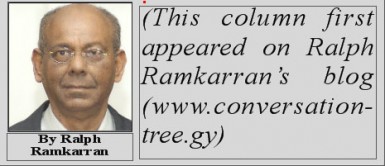
The designation of Guyana as ‘The Green State’ was not an accident. Dozens of characterizations could have been formulated to define Guyana’s intended adherence to a strict environmental regime, details of which are yet to be announced. But it is believed that the selection of the term ‘The Green State’ had something to do with the party colour and the President’s obvious attraction to it.
It is believed that in the absence of any serious programme to implement ‘The Green State,’ the President has decided to paint the entire country green, with the city going first, as a demonstration of the government’s commitment and as a way of whipping up political support. For example, the further popularization of the colour green will result in State House becoming known as ‘The Green House,’ just as the residence of the US President which is painted white, is known as ‘The White House’ and the blue-painted presidential palace in South Korea is known as ‘The Blue House.’
It is rumoured that after a suitable pause for the controversy over painting State House in green has subsided, quiet orders will be issued for other government buildings to be painted green. Parliament Building will be next because it is believed that the Speaker will offer no objection and will allow no debate because green is one of the component colours of the Guyana Flag and such a colour cannot be the subject of debate, as the Speaker has ruled on a previous occasion.
The next building to go will be the High Court. The Government will believe that even if there is objection by the Chief Justice it wouldn’t really matter because the Chief Justice can have her view and the President can have his view. This being the governing philosophy in relation to the judiciary, the government will obviously feel that even if the Chief Justice’s view were different to that of the President, it is the President’s view that will prevail.
Next on the agenda will be a refurbished City Hall. Reports are that the main ambition of the former Prime Minister and Mayor, His Worship Hamilton Green, was to paint the building green. Back in the day when Hammie was a big power, everything about him was green. His clothing, his pen, his ink, his vehicles, even his shoes. The rumour is that Hammie was so incensed that when his black hair started to change colour to grey instead of green, he shaved it all out in rage. Hammie would be hoping for a revival of his now defunct party, ‘Good and Green Guyana,’ not to challenge APNU, just in case his pension is jeopardized, but to support it.
It is a given that before the next election that Georgetown will be a green city, if not environmentally, then at least in colour, in line with Guyana’s green forests, green trees and green vegetation. The government believes that this colour revolution will inspire support because it would be one step closer to the achievement of ‘The Green State.’ But most people in the city already support the government. How then can the government extend the green revolution to other parts of the country, particularly where the opposition holds sway?
In relation to private buildings all over the country, including Georgetown, government will apply various sorts of persuasive techniques. To obtain government contracts, shop licences, customs waivers, drivers’ licences, ID cards, passports, and other concessions, owners of properties must first have all their buildings painted green. Soon, the government believes, all holdouts will eventually succumb to the green revolution. I am told that the opposition has received information that all government buildings such as schools, local government offices, health centres will be painted green after Georgetown.While the greening of the nation is going on, the government will keep a close eye on the opposition’s policy of non-cooperation. However, the government believes that such a policy will fizzle out as it did in the 1970s. It sees the evidence in the budget debate. The opposition has condemned the budget but is still participating in the debate. Just as the chaos in the National Assembly abruptly ended and Bishop Edghill meekly accepted his suspension by the Speaker, the PPP/C’s plan to deal with the green revolution is in utter chaos, which is also likely to dissipate. One sign of the chaos is that it is having difficulty in finalizing its opposition plan because it is not certain whether the non-cooperation should extend to refusing to campaign at all buildings with green roofs, or only at those painted green as a way of supporting the government’s agenda. Bishop Edghill supports an extension of time to discuss the matter, which the Central Committee of the PPP is being convened to resolve, at a meeting to be held at Red House.






